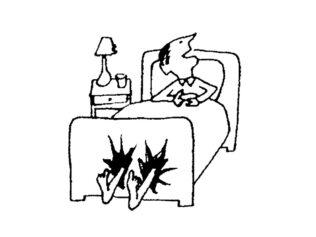
There are some people who fall asleep in their own bedrooms and wake up somewhere else entirely, in completely different circumstances. Facing murder charges, for instance.
Sometimes while they’re asleep, people sit up, walk around the house, or talk to themselves and their loved ones. But sleepwalkers can also commit brutal acts. Sometimes even murder.
Early in the morning of 24th May 1987, the Canadian Kenneth Parks, aged 23, left his house, got into his car and drove to his in-laws in Scarborough. He hit his mother-in-law in the head with a tyre iron and stabbed her in the chest multiple times with a knife. She died. Parks also tried to kill his father-in-law, but he survived.
Covered in blood, Parks drove to the nearest police station and told officers that he had just committed murder. At first, it seemed like a simple case: the man had recently lost his job, he was addicted to gambling, he had financial troubles. The most likely motive was therefore something to do with money. But the problem was that he had no reason to harm his wife’s family. On the contrary – they were on very good terms, he was like a son to them. His mother-in-law even called him her “gentle giant”. So why did he decide to commit such an act? During the attack, he was, quite simply, asleep.
The man was examined by expert neurologists and psychiatrists. They ruled out the presence of any drugs, psychotic states or dissociative disorders. He was interrogated numerous times to try and catch any inconsistencies in his account. To no avail. In 1988 Parks was acquitted; four years later the Canadian Supreme Court upheld the verdict.
He killed although he was sleeping
The Parks case was discussed at the 2011 World Science Festival by the psychiatrist and sleep disorder specialist Carlos H. Schenck from the University of Minnesota. The scientist was certain: the judicial decision was correct. Schenck pointed to the fact that, among others, while brandishing the knife at his in-laws’ house, Parks cut himself in the palm and severed his flexor tendons. But while speaking to the police officers, he showed no sign of pain.
During the Festival’s panel discussion, Schenck explained: “That was very important evidence to indicate that he was not really awake.” He added that when conscious, people with severed tendons experience excruciating pain. There were also other essential facts. As he left his house at dawn, Parks left the front door and garage door wide open. He had previously sleepwalked: when he was 11 he narrowly avoided falling out of the window because of it. Furthermore, parasomnia – that is, sleep disorders – had been diagnosed in 20 of his family members. He suffered from insomnia; he was stressed because of his financial problems and the increasing tension with his wife that they were causing.
As Schenck emphasizes: “He had no motivation to kill his in-laws.” We can only imagine the cause. Right before the murder, Parks fell asleep in front of the television while watching Saturday Night Live, during which several violent scenes were shown. Another theory states that the man might have been caught walking around his in-laws’ house and the attempts to stop him or wake him up provoked the aggressive reaction.
Let some sleeping people lie
Today we know for sure that Parks experienced somnambulism, known commonly as sleepwalking. This is a disorder that affects around 1-3% of adults. The good news is that crimes committed by this group of people are exceptionally rare.
“Somnambulism belongs to a group of sleep disorders in which the abnormality occurs during the non-REM phase of sleep [so-called ‘deep sleep’ – ed. note]. It is believed that symptoms of somnambulism are the result of improper (incomplete) waking from deep sleep in the non-REM phase,” write Konrad Janowski, Agnieszka Jelińska and Aleksandra Waś in “Somnambulism: Clinical Manifestations and Therapy”, in the journal Roczniki Psychologiczne [Annals of Psychology].
It’s not only sleepwalkers who can be aggressive, but also people who are suddenly jolted from their sleep and aren’t yet fully awake. This is known as sleep drunkenness (so-called Elpenor’s syndrome). Jerzy Pobocha, a psychiatrist and expert witness, once identified this disorder in a soldier, who in the 1970s was referred for routine checks at a psychiatric hospital.
“Soldiers,” the psychiatrist told me, “were often used to help restrain patients. This was also the case for this man – he was often woken by staff during the night.” On one occasion, his eyes still closed or half-closed, the soldier grabbed a nurse around the neck and started to throttle her. Later on, he had no recollection of this, and what’s more, he had no reason to attack her. Another example Pobocha mentioned comes from German academic literature. A lawyer was on a train journey, in a sleeping car. He was tired, he’d been working hard. When the border guard came to check his passport, he attacked him.
What if sleep is just an excuse?
According to the article “Homicidal Somnambulism: A Case Report”, published in 1994 in the academic journal Sleep, the first documented case of murder committed by someone when asleep is likely to be a case from the Middle Ages, which is said to have occurred in Silesia.
Bernard Schedmaizig, a woodcutter, woke up suddenly after several hours of sleep, saw what he thought was an intruder next to be his bed and attacked him with an axe. The ‘intruder’ turned out to be his wife, who was asleep next to him. Other cases have also been described: a servant who stabbed her employer’s child to death; a London housewife who threw her own baby out the window; a father who hit his son’s head against the floor; a firefighter who killed his wife with a spade.
But all of this begs the question: how do you know the attack actually took place during sleep, and it isn’t just the offender’s excuse as they try to get away scot-free? As Jerzy Pobocha writes: “It doesn’t only matter what the perpetrator says about the act, it’s also what the act and its circumstances say about the perpetrator. It isn’t that the perpetrator tells me a story and I naively believe it.”
The accused is subject to brain activity tests, among others. A CAT scan is carried out, as well as a detailed interview about their health. Analysis of the event takes into account the assailant’s personality and whether any potential motives for the crime can be identified. An essential indicator for investigators can also be the automatic behaviour of the perpetrator – whether at the time of the event they were ‘driven’ by something; whether they reacted to their surroundings.
Verdict: Not guilty!
How does Polish law treat a murderer who killed while asleep? “This is not an act as defined by law. If someone were to insist that it is an act, then it certainly isn’t a culpable one,” explains Teresa Gardocka, a specialist in law, criminal proceedings and international criminal law at the SWPS University.
Gardocka stresses that the crime must be committed with intention – whether direct or indirect – or unintentionally, that is, through negligence or recklessness. Therefore, in theory, a sleepwalking murderer should not even face charges, not to mention a guilty verdict.
Kenneth Parks remains free to this day, but his relationship with his partner did not survive the difficult events. He underwent psychotherapy and started taking medication before bed as prescribed by his doctor. He doesn’t give interviews. And so we don’t know if, despite the many years that have passed, he sometimes wakes in the middle of the night in fear and checks he’s really lying in his own bed.

Translated from the Polish by Zosia Krasodomska-Jones










